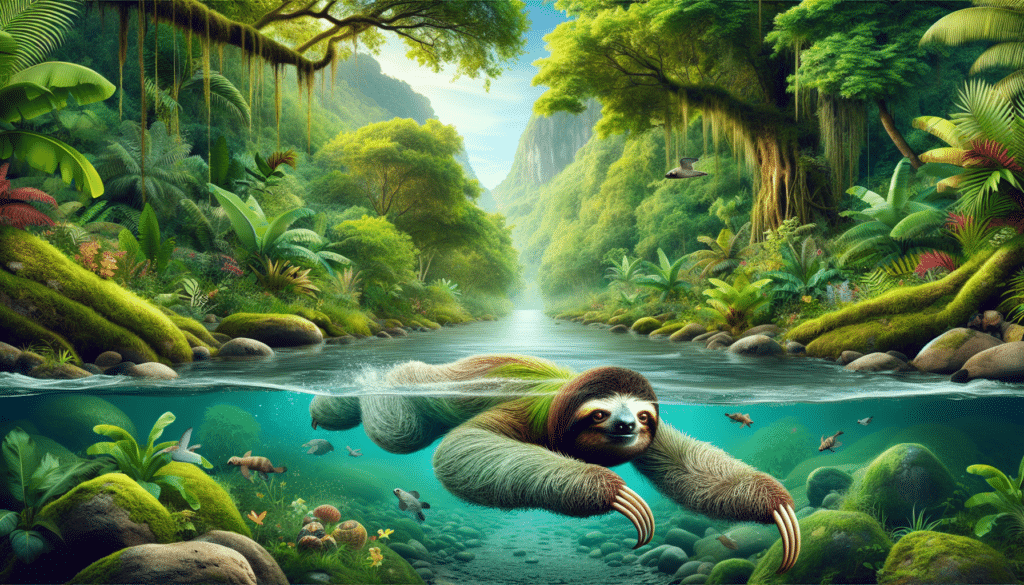“`html
Did you know that sloths, the OG couch potatoes of the animal kingdom, are actually incredible swimmers?
Surprise, right? These slow-motion tree-dwellers transform into aquatic ninjas when they hit the water. And trust me, their swimming skills aren’t just for showing off at the rainforest pool party—it’s a game-changer for their survival.
Buckle up, because we’re diving (pun totally intended) into the fascinating world of sloths and their unexpected swimming superpowers.
Sloths’ Unique Habitat and Lifestyle
Table of Contents
ToggleSloths call the lush rainforests of Central and South America home—a green paradise woven with rivers and streams.
Living high among the canopy trees, these slow movers face a lot of habitat obstacles, like gaps in the treetops and, oh yeah, rivers casually interrupting their commute.
For sloths, it’s “swim or starve” out there. Their ability to navigate waterways isn’t just handy—it’s downright vital for survival.
Fun fact: In the dense jungle, swimming isn’t just a survival skill—it’s part of their sloth genius. Want to nerd out more about their habitat? Check this out here.
The Physiology Behind Sloths’ Swimming Abilities
Okay, here’s some wild science for you: sloths are built for stealth in the water. Their long limbs and slightly webbed fingers act like natural paddles. Michael Phelps, watch out!
Even cooler? Sloths can hold their breath underwater for up to 40 minutes (yes, longer than you hold yours trying to impress your friends in the pool). They achieve this because their heart rate slows way down, conserving oxygen like pros.
Bonus points: Their dense fur doubles as insulation and a built-in floating device. Who needs pool noodles when you’re a sloth?
Energy Conservation: A Sloth’s Survival Strategy
Here’s the thing about sloths—they live life in the slow lane, and I respect that. But swimming, surprisingly, is a clever energy hack for them.
Water supports their body weight, meaning less energy spent schlepping around like a clumsy tourist with a heavy suitcase. It’s a trade-off that suits their slow metabolism perfectly.
More distance, less energy burned—a win-win for these glorious tree huggers.
Escaping Predators Through Aquatic Routes
If you’re a sloth hanging out in jaguar territory, what’s your escape plan? While jaguars and eagles might have the upper hand on land or in trees, few predators can catch you if you paddle your way to safety.
In water, sloths become ghost mode ninjas, slipping away and avoiding detection. Swimming isn’t just a fun party trick—it’s life-saving genius.
Sloth Movement: Land Versus Water
Picture this: On land, sloths crawl at a sluggish 0.17 miles per hour—a literal crawl of shame.
In water, though? They turn into aquatic MVPs, swimming up to three times faster than their land speed. It’s like trading in a broken scooter for a speedboat!
That’s the kind of glow-up we love to see from our slow-and-steady rainforest besties.
The Role of Swimming in Feeding and Reproduction
Swimming isn’t just about avoiding snooty jaguars—it’s also their ticket to new buffets. Crossing streams or rivers opens up new snacking grounds (hello, tasty fruit trees) that would otherwise be out of reach.
But wait, there’s more! Sloths also expand their dating pool when they paddle to new neighborhoods to meet potential mates. It’s romance, sloth style.
Observing Sloths in Their Natural Environment
If you’re itching to see these furry swimmers in action, hop on a guided rainforest tour. Trust me, nothing will humble you faster than watching a sloth out-swim you when you’re canoeing.
Pro tip: Choose eco-friendly operators that respect the animals and their wild crib. Adventure is awesome, but conservation is king.
Responsible tourism is how we keep these jungles sloth-friendly for generations to come.
Documentaries Showcasing Sloth Behavior
Not ready for a jungle expedition? No problem! There are top-notch documentaries that bring sloths into your living room. “Meet the Sloths” is my personal fave—it’s full of drama, charm, and all things sloth.
These films don’t just entertain—they educate, bringing you closer to understanding the quirky, chill lives of our tree-hanging pals.
Find This and More on Amazon
Conservation Efforts and How You Can Help
Rainforest deforestation and human encroachment are raining on the sloths’ parade, but we can help flip the script.
Support organizations dedicated to preserving their habitat. (Trust me, your dollars go a long way.)
Protecting these slow-moving superstars ensures that future generations can marvel at their quirky charm and aquatic ninja vibes.
Embracing the Slow Life: Lessons from Sloths
Let’s face it: sloths are pros at conserving energy and rolling with life’s punches. Their unique swimming ability is proof that adaptability can overcome even the laziest of reputations.
By understanding these creatures, we gain insight into a delicate ecosystem—and a reminder that going slow doesn’t mean you’re failing; it might just mean you’re surviving brilliantly!
So, embrace the slow and steady life. The sloths are rooting for you (probably from a tree or cozy riverbank somewhere).
“““html
Myths and Misconceptions About Sloth Swimming
Alright, let’s tackle the big question: “Can sloths even swim?” Spoiler alert: Yes, they can! And no, they aren’t just lazy fluffballs floating through life. Sure, sloths are known for taking things slow (like, super slow), but when survival kicks in, they dive into action like furry little Michael Phelps wannabes. 🏊
One myth we totally need to ditch is the idea that sloths only hit the water when they’re in danger. Not true, my friend. Sometimes, they’re just exploring or looking for their next lush, leafy snack. Let’s give these guys some credit—they’re way cooler than most people assume.
Busting these myths not only clears the air but also makes us realize how downright awesome sloths really are. Trust me, they’re full of surprises.
Comparing Sloth Swimming to Other Mammals
Sloths aren’t the only unexpected swimmers out there—turns out, the animal kingdom is full of aquatic curveballs! Take deer, for instance. Did you know some species of deer can swim across rivers like it’s no big deal? Who knew Bambi had such impressive moves?
Much like sloths, deer aren’t out there doing laps for fun—they’re crossing rivers to find food or safer homes. So hey, maybe sloths and deer should form a “Secret Swimmers Club.” 🦥 + 🦌 = water warriors.
If you’re curious to dive deeper into the swimming prowess of deer, check out this interesting resource here.
The Impact of Climate Change on Sloth Habitats
Buckle up—it’s getting serious now. Climate change is seriously cramping the sloth’s chill vibe. Rising temps and funky rainfall patterns are reshaping the rainforests these sleepy swimmers call home. Not cool, planet, not cool.
What does this mean for sloths? Well, fluctuating river levels can either flood their favorite hangouts or block off vital areas. Imagine having to swim further through rising waters just for lunch—it’s like combining grocery shopping with an Olympic event. No one’s signing up for that.
This is why protecting rainforests and tackling climate change is so crucial—not just for sloths but for the entire web of life that relies on these ecosystems.
Sloths in Popular Culture
Let’s face it: sloths are celebrities in the animal world. Between starring roles in animated movies and conquering memes online, their chilled-out charm is impossible to resist. I mean, who wouldn’t want to be reminded to “hang in there” by a permanent couch potato?
But beyond the laughs and facepalms of “sloth goals,” their internet fame is actually helping the conservation game. The more people fall in love with these furry icons, the more awareness and support we can rally for protecting their habitats. So, keep those sloth memes coming—it’s for a good cause. 👍
Scientific Studies on Sloth Swimming
Scientists—armed with clipboards, GPS trackers, and an unusual appreciation for slow animals—are diving deep (literally) into sloth swimming behavior. They’re monitoring their water movements, studying their strokes, and probably marveling at their ability to stay afloat with so little effort.
Why? Because all this research helps us understand how sloths survive and adapt in changing environments. More knowledge equals better plans to protect these chilled-out creatures and their homes. Science for the win!
Products Inspired by Sloths
If sloths had a merch line, it’d be the chillest collection ever—and guess what? They kind of do! From ridiculously cute sloth blankets that’ll slow your mornings down to sloth-themed books for curious minds, the options are endless.
Plus, a lot of these products help fund conservation efforts. So, every time you wrap yourself in that plush sloth hoodie, you can feel good knowing you’re making the world a better place for our slow-moving friends.
Find This and More on Amazon
Engaging Children with Sloth Education
Want to raise a little conservationist? Let’s start with sloths. Interactive books, fun documentaries, and even sloth-themed coloring kits are great ways to get kids hooked on these lovable tree-dwellers. Who needs superheroes when you’ve got sloths inspiring little ones to save the world?
The goal here is simple: spark curiosity and nurture a love for the environment in the next generation. Because the more we teach now, the better we’re setting up the future caretakers of this planet. 👧🧒🌿
Ecotourism and Its Benefits
If trekking through lush rainforests to spot wild sloths isn’t on your bucket list, well, add it! Ecotourism gives you a chance to meet these animals in their natural digs while supporting local economies.
But here’s the catch: it’s got to be responsible. Choose eco-conscious tours or sanctuaries—ones that prioritize the welfare of the wildlife they showcase. It’s a win-win for curious explorers and Mother Nature alike.
Other Animals Sharing Sloth Habitats
The rainforest isn’t just about sloths (though they are the undeniable VIPs). It’s a whole bustling community of creatures sharing the same turf. For example, bats—like the incredibly cool Mexican Free-Tailed Bat—play a huge role in the ecosystem.
Appreciating these interconnected species helps paint the bigger picture of why rainforests need our protection. Curious about bats? Dive into their world here.
Protecting Rainforest Biodiversity
Every creature in the rainforest, whether it’s a teeny-tiny insect or a roaring jaguar, plays a part in keeping the ecosystem alive and thriving. By saving sloths, we’re also protecting a cascade of other species that depend on the same habitats.
It’s all connected—a giant, living jigsaw puzzle. Let’s make sure we don’t lose any pieces.
Takeaways: Sloths as Symbols of Adaptation
Sloths have a life lesson for all of us: you don’t have to be fast to be strong. They’ve mastered the art of adapting to their surroundings—whether on land, in trees, or in the water. That’s a skill worth celebrating.
So next time you’re overwhelmed, channel your inner sloth. Slow down, adapt, and handle life with the quiet, graceful resilience of these incredible creatures. 🦥
“`



